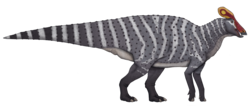| Tlatolophus Temporal range: Late Cretaceous, Campanian | |
|---|---|
 | |
| Speculative life restoration | |
| Scientific classification | |
| Kingdom: | Animalia |
| Phylum: | Chordata |
| Class: | Reptilia |
| Clade: | Dinosauria |
| Clade: | † Ornithischia |
| Clade: | † Ornithopoda |
| Family: | † Hadrosauridae |
| Subfamily: | † Lambeosaurinae |
| Tribe: | † Parasaurolophini |
| Genus: | † Tlatolophus Ramírez-Velasco et al., 2021 |
| Species: | †T. galorum |
| Binomial name | |
| †Tlatolophus galorum Ramírez-Velasco et al., 2021 | |
Tlatolophus (meaning "word crest") is a genus of hadrosaurid dinosaur belonging to the tribe Parasaurolophini that lived during the Campanian stage of the Late Cretaceous in what is now Mexico. The only species is the type species, Tlatolophus galorum.

